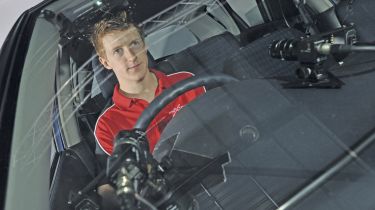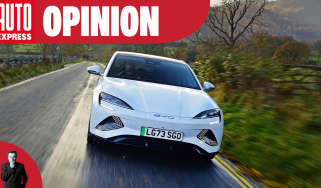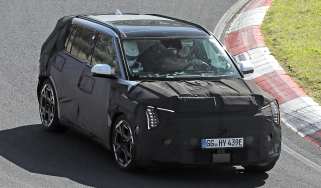The Weakest Blink?
Three bumper-bashing BTCC stars meet our reporter Will McManus to find out who’s safest on the road. The eyes have it in a driving test with a difference!

With thousands of hours of nail-biting competitive experience behind the wheel, the stars of the British Touring Car Championship are some of the most highly skilled drivers around.
But does this count for much when they leave the circuit? And on everyday roads, are they really any different to the average motorist?
Auto Express decided to put them to the test in a bid to find out. And what better way to do that than invite three of the series’ leading lights to ‘drive’ in the most advanced and realistic simulator in the country, at the Transport Research Laboratory (TRL) in Wokingham, Berkshire?
Just for good measure, I would be pitting my wits against them, too!
The simulator
Constructedin 2003, the CarSim is nothing like the shuttle-shaped simulators you see at the funfair. For a start, it’s spread across two labs. Sitting in the centre of the main room is a previous-generation Honda Civic five-door, surrounded by six enormous projector screens that display the three-dimensional world in which you drive. From the outside, it looks a bit like an old movie set used for driving scenes – but the technology is more Batmobile than Herbie.
The Civic is fixed to the floor, and its engine has been removed. In its place and throughout the cabin there are dozens of wires, computer modules and video cameras dedicated to tracking your every movement and interaction with the vehicle – and from the driver’s seat, everything works.
Used - available now

2019 BMW
1 Series
55,000 milesAutomaticPetrol1.5L
Cash £14,690
2022 Kia
e-Niro
23,188 milesAutomaticElectric
Cash £14,500
2023 Vauxhall
Corsa
7,145 milesManualPetrol1.2L
Cash £11,567
2023 Tesla
Model 3
35,546 milesAutomaticElectric
Cash £18,300When you turn the steering wheel, change gear or even switch on the headlights, your inputs are sent through a complex array of PCs, analysed and translated to what you see on the screens. This all happens in real time, so once you’ve got used to the slightly alien sensation of sitting still while your eyes think you’re moving, the simulator feels amazingly realistic.
The facility even has an EEG monitor that measures brain activity – so if a test driver claims they were comfortable during an assessment, the researchers
at TRL can effectively read their minds to see how they really reacted!
The blacked-out control room houses the 16 computers that operate the different parts of the simulation – from the 3D images projected around the car to the sounds pumped through its speakers and even the hydraulic system that makes it feel as though it’s moving. A bank of monitors shows the route being driven, as well as digital versions of the car’s instruments and graphical representations which translate your drive into data.
One of the cleverest things the simulator can do, however, is test your reactions. Using a trio of dashboard-mounted cameras, it creates a 3D model of your face and eyes, and takes a reading 60 times every second to track where you look and record how you read the road. This was the main focus of our test.
The drivers
the three drivers I’d be taking on were professionals with different levels of experience in the BTCC – ranging from a championship-winning veteran to an up-and-coming prospect. Easily the most established of our star trio was Matt Neal. The 42-year-old Worcestershire-born VX Racing man contested his first BTCC round in 1991, and has two drivers’ crowns under his belt. He leads the 2009 standings, having taken one victory and a string of podiums.
Next up was Portadown-based Colin Turkington, who drives a BMW 320si for Team RAC. A BTCC driver since 2002, the 27-year-old enjoyed his best season three years ago, when he finished third overall. But this year is shaping up to be even better, as he’s currently sitting in second place on the championship leaderboard.
Also taking the wheel of our simulator is Liam McMillan, who at 19 is the youngest competitor in the 2009 series. It’s his debut season in the BTCC, and he only earned his roadgoing licence two years ago – so how would he fare on the test? And crucially, how well do all three of our star drivers think their skills on the race track can be transferred to day-to-day driving on the road?
Before the test, Colin said: “I suppose I’ve got quite a lot of driving experience, but I’ve also picked up a number of bad habits. When you’re on the track, you rarely use the mirror and have no concept of sticking to 30mph.”
So, do all the BTCC drivers keep to a racing line on the road? Colin claimed the opposite is true. “I do a great deal of travelling, and simply can’t afford to lose my licence,” he explained. “For that reason, you just can’t go round acting like a maniac on the roads.”
Matt added: “It sounds unlikely, but because we’ve got the track to vent our aggression on, we all drive like grannies on the road! Races are so tiring – both mentally and physically – that you usually drive home very calmly and carefully to bring yourself back down from all the excitement.”
The Test
So, what did we measure? Our test looked at how all four drivers read the road, and how closely linked their eye movements were to their steering inputs. TRL’s Dr Mark Chattington, who ran the simulator, says that looking further ahead and displaying a close link between eye movements and steering – or having good ‘eye-steering co-ordination’ – is a sign of an efficient driver.
He added: “As we move along, there are many different methods used to keep the car in between the white lines, and control the vehicle.
“One of the fundamental ways of studying this is to look at how the eyes move, compared to the steering wheel. Eye movements feed directly into the process of planning how to steer, and this generally changes depending on a driver’s level of training.”
Prepared for the test after a brief familiarisation drive, I took to the virtual road ahead of our BTCC stars. In all, the course lasted 10 minutes, and the route featured a mixture of sweeping country roads and busy village streets.
The Results
Unsurprisingly, our racers achieved higher scores for co-ordination than I did. But the gulf in our performances was a bit of a surprise!
The results were divided into two parts. Firstly, there was a ‘time lead’ or thinking time score, which showed how far ahead a driver planned their steering movements. The longer the gap between the driver seeing a road feature – whether it’s a corner, pedestrian or other traffic – and reacting to it, the more time you have given yourself to prepare for it.
The second section of results was a measure of the drivers’ eye-steering co-ordination – that showed how closely linked eye movements were to steering inputs. A higher percentage score reveals how much of your ‘looking’ is used to make changes to your direction.
Dr Mark Chattington explained: “When driving, it’s really important to be on top of your actions and to have the right information available at the right time. Your brain usually takes a set period to process this, so good eye-steering co-ordination and a long lead time mean you’re better prepared for the road ahead.
“Experienced drivers tend to look to the vanishing point instead of directly in front of the car, so they have a little bit longer to calculate the information, meaning they have more of a planning process and a better performance.
“When people are impaired by alcohol, fatigue or drugs, we’ve found their co-ordination decreases, almost to the point that they don’t make eye movements before they need to steer. That’s why they are more likely to run off the road or into oncoming traffic.”
I ended up with a thinking time of 1.03 seconds and an eye-steering co-ordination of 55 per cent. So, only half of my eye movements were actually related to following the road! Our BTCC drivers averaged a thinking time of 1.56 seconds – 50 per cent more than mine. Their steering inputs were also much more in line with eye movements, at an average 79 per cent. So, most of their time was spent looking at the oncoming route and keeping to a smooth path.
Why do our racers have such good reflexes and response times then? The answer lies in their training. While BTCC regulations now limit on-track practice and testing time, all three stars have far more experience behind the wheel than the average driver. Even relative newcomer Liam no longer receives instruction, but they were all blooded in race technique as they came through the ranks.
“I’m just used to looking as far ahead as possible,” explained Liam. “I was always taught that you drive where you look, so my concentration is usually on what’s coming up ahead rather than the road immediately in front of me.”
Yet that doesn’t mean the drivers are totally unaware of what’s going on around them. Colin says he has attuned his hearing to recognise the positions of drivers nearby, and Matt claims racers even use a ‘sixth sense’ to detect their competitors by feeling for changes in air pressure!
So, are they really much better on the road? Without doubt, their training helps them keep track of their immediate environment. Having to watch out for rivals trying to overtake and recognising gaps and spaces between vehicles also means their spatial awareness is far superior to that of a normal motorist. But does it then follow that the average driver is less capable?
Not so, according to Dr Chattington. “A lower score does not mean you are a worse driver, it just means that you react to things differently,” he explained. “One thing everyone has to do when they’re behind the wheel is concentrate.”


